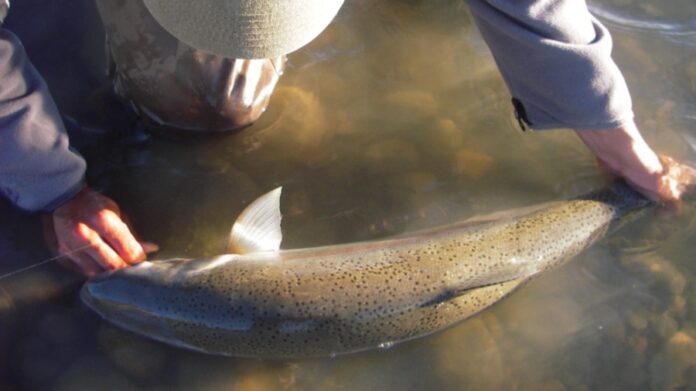Photo by Evan Jones
Patagonia is a surprisingly big place: with a total area of over 250,000 square miles, it’s larger than California and Oregon combined. And just like those states, Patagonia also boasts a huge variety of biomes and fisheries, each with its own unique character and appeal. So if you’re among the growing number of anglers considering taking a trip down there, you’ll want to ensure that your chosen destination is a good match for your expectations and aspirations, because there are a lot of different options.
The Argentine side, which makes up about 90% of Patagonia, can be conveniently broken down into 3 distinct zones: Northern, Central, and Southern. This series will highlight the main features, benefits, and potential drawbacks of fishing in each zone so that readers can make more informed decisions about visiting this remote part of the world.

Photo by Ryan Davey
The Southern Zone
The southern zone consists of the lower half of Santa Cruz province–where rivers begin to flow eastward again–all the way down to the landmark city of Ushuaia at the bottom of Tierra del Fuego, nearly 1,000 kilometers away. The landscape here is desolate, cold, and dry, with precious few trees and strong, persistent winds. Western Santa Cruz contains several large glaciers that lend a brilliant turquoise hue to most lakes and rivers there, while the island of Tierra del Fuego features mostly tea-stained creeks meandering through marshy tundra. Turbid water with very little insect life is the general rule, although the presence of anadromous brown and rainbow trout from the nearby South Atlantic mean this region actually has some of the largest trout of all. This is the truly wild and remote part of Patagonia.

Photo by Evan Jones
Most of Santa Cruz province is extremely difficult to access. There are only a couple of paved roads and a couple of cities of any real size (Río Gallegos on the coast, and El Calafate in the mountains to the west) throughout the entire region, surrounded by endless swaths of harsh, empty land. The trout fisheries are also very far apart, sometimes requiring multiple days of travel between them–without passing a single gas station or grocery store along the way–adding to the already considerable logistical challenges of fishing here. Tierra del Fuego is small enough that it’s relatively easy to access by comparison, but be aware that the high-water-mark rule isn’t always observed there. This can limit your access to certain places such as the Río Grande, which mostly flows through closely-guarded private property. All things considered, it’s best to make reservations with a lodge or a full-service outfitter for trips to the southern region, so that you won’t have to worry about getting stuck in the middle of nowhere or finding public places to fish.

Photo by Evan Jones
You can catch fish all season long in the southern region, but many anglers will want to time their trips to coincide with the seasonal runs of sea trout and steelhead. The sea trout run typically begins in December, peaks sometime in January, and continues into February. The steelhead run is shorter and more fickle, typically beginning in late March and peaking sometime in April, and is limited only to the Santa Cruz river. The few lodges/outfitters in this area tend to book out years in advance, so you’ll want to plan ahead as far as possible. You should also consider blocking out an extra day or two at the beginning and the end of your trip, in case your domestic flights are delayed or other travel issues arise.
For more information on fishing in Argentina, CLICK HERE or call Orvis Travel’s Jeremy Kehrein at 1-800-547-4322.
Click these links to learn about the Northern Zone and the Central Zone.
Evan Jones is the assistant editor of the Orvis Fly Fishing blog. He spent two years living in Argentina and writing a popular guidebook on the region, and now makes his home on the Front Range of Colorado.
Credit: Source link






























